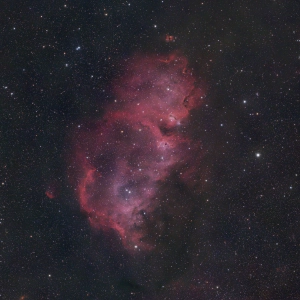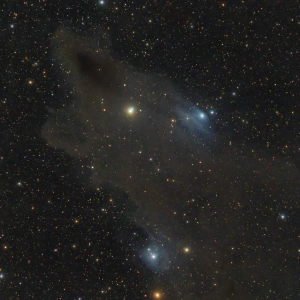Dark nebulae
Emission nebulae

Close your eyes and imagine a nebulae in space.
Now did you think of a brightly colored nebulae, probably red or in yellowish/blue? Well, most people would as these are the images we are used to see when looking at images from hubble or astrophotographers in general.
These nebulae, like the soul nebula on the left, are clouds of dust and gas which emit light by themself. There is usually a very bright star which emits photons which causes the gas to ionize and glow. Depending on the gas different wavelength of light are emitted: Hydrogen-alpha will glow red, oxygen blue and sulfur green. If you want to read more about it there is a wikipedia article about emission nebulae .
Dark nebulae

Now dark nebulae, sometimes called absorption nebulae, are clouds of dust that do not glow. If you want to take pictures of these you basically photographing the missing of light, which is hard.
In astrophotography we use a process called stretching to bring out the details in our images. If we take a picture all the information is tightly packed in the dark areas of the image. By stretching these areas out in the brighter areas and thus compressing the bright areas we can make the faint details visible. This also brings out all the noise in this area so one need to compensate by taking many pictures and combining them.
Now for emission nebulae I usually take around 6 to 10 hours of data for a single image so the noise is at a bearable level. Because dark nebulae are not as bright (duh!) the data is more densely packed and thus needs more stretching which brings out the noise even more. I would assume that I would need around 40 hours’ worth of data for the same quality as 10 hours of an emission nebula.
Dark skies and a scope which can gather light really fast helps a tremendous amount but I can’t change these two for now. That is the reason I didn’t try to image one - yet ;)
The shark and his little friend
As I said, I never imaged on before but I had my eyes on the dark shark for a while now. Also with the new gear and knowledge I think I can pull it off so here is a preview of my first dark nebula: meet the shark and his little friend, the angler fish!

That is quite a sight - is it not? This isn’t completed yet, I’m just 10 hours in and want to go to at least 40. Also given the nature of these nebulae I only want to image it in moonless nights which are clear and these are hard to come by.
But I’m kinda proud of my progress so far so I wanted to share it with you. It will probably take all some and maybe autumn to complete it and I’m really looking forward for the final image.
